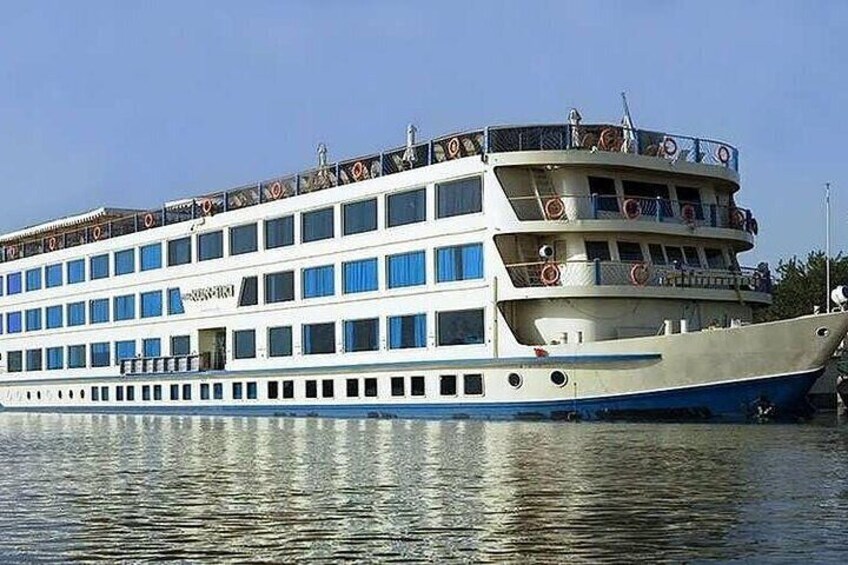Members save 10% or more on over 100,000 hotels worldwide when you’re signed in





4 Nights Cruise Luxor, Aswan, Abu simbel, Balloon,and Tours By Bus From Hurghada
Features
- Free cancellation available
- 5d
- Mobile voucher
- Instant confirmation
- Selective hotel pickup
- Multiple languages
Overview
Savour the timeless experience that is a Nile cruise as you sail from Luxor to Aswan on an indulgent ship with on board swimming pool.
Feast on breakfast, lunch, dinner—and even afternoon tea—as you discover ancient Egypt’s highlights.
Professional Egyptology are on hand as you visit the temples of abu simbel, Philae,high dam, Kom Ombo, Edfu, valley of the kings,Hatsheput,clossi of memnon, and Karnak.
Cruise the Nile with overnights in Aswan, Edfu, and Luxor.
Learn about ancient Egypt from professional Egyptology guide.
Enjoy a full-board feast, a swimming pool, and ample on board entertainment. train tickets,meals and all transfers are included.
door to door transfer from and to your hotel.
valley of the kings and so much more with an Egyptology guide.
visit the great abu simbel temples.
touch the great culture in luxor and Aswan
Activity location
- Hurghada
- Hurghada, Egypt, Egypt
Meeting/Redemption Point
- Hurghada
- Hurghada, Egypt, Egypt
Check availability
4 Nights Cruise Luxor, Aswan, Abu simbel, Balloon,and Tours By Bus From Hurghada
- 5d
- English
Pickup included
What's included, what's not
- horse and carriage in edfu
- 4 nights accommodation in 5 star Nile Cruise from Luxor To Aswan
- motor boat in Aswan
- Free Wi-Fi over 4GB per person
- Hot Air Balloon Trip
- Assistance of our personal during the tour Portage when needed
- all taxes and charges
- Bus Tickets
- all the transfers as in itinerary
- all the sites which mentioned in itinerary
- handling fees
- cabin with all facilities
- Entrance fees
- Tipping
Know before you book
- Specialised infant seats are available
- Public transport options are available nearby
- Infants and small children can ride in a pram or stroller
- All areas and surfaces are wheelchair accessible
- Transport options are wheelchair accessible
- Suitable for all physical fitness levels
- Wheelchair accessible
Activity itinerary
Day 1: Pickup From Your Hotel In Hurghada To Bus Station To Catch Bus To Luxor and Visit Temple Of Karnak and Luxor Temple
- 3 stops
- Meals: lunch, snacks
- Accommodation: Overnight Nile Cruise Boat In Luxor
Hurghada
- 3h
Temple of Karnak
- 2h
Luxor Temple
- 2h
Day 2: Hot Air Balloon & Valley Of The Kings, Hatshbsut Temple, Colossi Of Memnon & Sailing To Edfu
- 4 stops
- Meals: breakfast, lunch, snacks
- Accommodation: Overnight Nile Cruise Boat In Edfu
Hot Air Balloons Luxor
- 1h
- Admission ticket included
Valley of the Kings
- 2h
- Admission ticket not included
Temple of Hatshepsut at Deir el Bahari
- 1h 30m
Colossi of Memnon
- 20m
- Admission ticket included
Day 3: Visit Temple of Edfu & Sailing To Temple Of Kom Ombo
- 2 stops
- Meals: breakfast, lunch, snacks
- Accommodation: Overnight Nile Cruise Boat In Aswan
Temple of Horus
- 3h
Temple of Kom Ombo
- 3h
Day 4: Abu Simbel Temples Complex
- 1 stop
- Meals: breakfast, lunch, snacks
- Accommodation: Overnight Nile Cruise Boat In Aswan
Abu Simbel Temple Complex
- 7h
Day 5: Temple Of Philea and Aswan High Dam Then Catch The Bus From Aswan Back To Hurghada
- 2 stops
- Meals: breakfast
- Accommodation: Bus Back To Hurghada From Aswan
Temple of Philae
- 2h 30m
Aswan High Dam
- 1h 30m
Location
Activity location
- Hurghada
- Hurghada, Egypt, Egypt
Meeting/Redemption Point
- Hurghada
- Hurghada, Egypt, Egypt